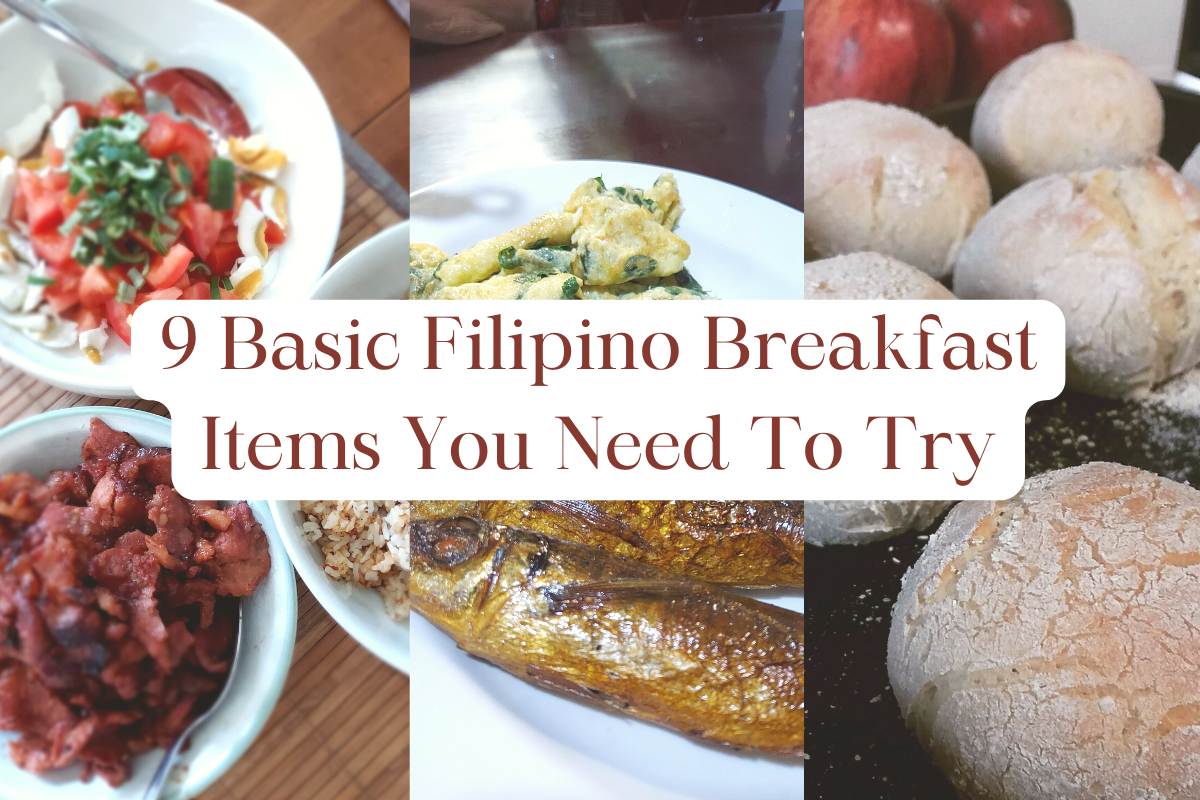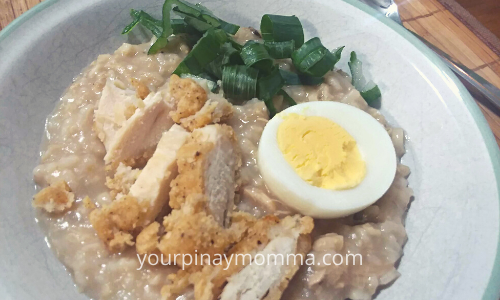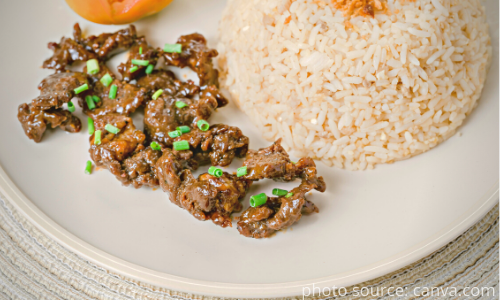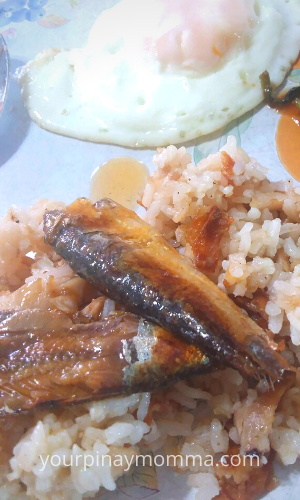
Last updated on May 9th, 2022 at 03:53 pm
Have you eaten a Filipino Breakfast?
Breakfast is often regarded as the most important meal of the day. It’s also the easiest meal to practice making and master with little effort.
As a migrant in the U.S., I have learned to appreciate all the yummy American breakfasts I’ve had for the past 7 years. But Filipino-style breakfasts will always be my jam. I try my best to serve them equally in our household, scheduling to alter them every week or so.
If you’re not quite ready to dive into lumpia or pancit just yet, here is a no-fuss introduction to the 9 Filipino Breakfast Items that can happily wake up your senses (and tummy)!
*note: clicking on the links in this page may earn me a small commission at no extra cost to you.
1. Sinangag – Garlic Fried Rice
A Filipino breakfast is not complete without Sinangag. It is the most basic thing you can make. The ingredients consist of day-old rice (meaning you made it the day/night before) and a ton of garlic, toasted and stir-fried together with the rice. It goes well with any other dish included in this post, but if you’re in a pinch, partner it with a fried egg and it will work out just fine.
I made a quick video on how to make your basic garlic fried rice here:
2. Pandesal – Soft Filipino Bread Roll
If you’re not a heavy eater at the start of the day, you can opt for this bread instead!
Pandesal, sometimes spelled out as pan de sal, translates as “salt bread” in Spanish. It is a light and airy type of roll and the most basic type of Filipino bread you can have. Unlike the name, though, this is not salty; the bread is more on the sweet side, with sugar and a little milk used when baking.

Growing up, these are sold by vendors with heated bins attached to their bikes, fresh out of the oven from a local bakery. One of the standard ways to eat them is to tear a piece and dip them in coffee or hot chocolate.
If you’re lucky to find these in a Filipino store, don’t hesitate to try them.
3. Lugaw – Rice Porridge
Rice porridge is one meal that comes to mind when someone is sick. But then you can’t wait until you’re sick before you enjoy its soothing, heartwarming goodness.
It is basically made with glutinous rice or sticky rice (malagkit) and aromatics like garlic, ginger, and onions. If it’s challenging to find glutinous rice where you’re at, don’t worry, it is easy to sub it with regular white rice with a few tweaks.

There are also numerous variations of this dish, like Goto (porridge with beef tripe), and Arroz caldo (with chicken pieces).
4. Eggs Torta Ala Pobre – Poor Man’s Eggs
Sure, we partner everything with fried rice and a fried egg. We even had a name for it– Silog- Meaning “SInangag” and “itLOG” (eggs). But Eggs Torta is different.
“Pobre” translates to “poor” in Spanish. I would often hear my grandparents call a dish that ends with this phrase. In cooking, it just means that the ingredients used are common and so cheap, that it will stretch whatever you’re making to feed a big family.
Eggs are obviously the star of the show but with help of other ingredients like garlic, onions, tomatoes, and potatoes. You fry the potatoes first, then saute them with the other ingredients.
This dish can be very flexible, you can use whatever ingredients you have on hand. The goal is to extend more life from the eggs by combining them with whatever else you have in your kitchen.
Breakfast Meats / Processed Meats
Now let’s move on to breakfast meats. This mainly consists of pork, sometimes chicken or beef.
5. Longganisa
Longganisa is a Filipino-style sausage that originates from Spain (longaniza). It mainly consists of fresh ground pork and fat with seasonings like garlic, onions, vinegar, peppers, sugar, and sometimes chili. It comes in different sizes and flavors depending on which province you go to. So far the most popular one is the Kapampangan sweet-style longganisa, which you can easily find at Asian stores.

My grandmother is Bulakenya, so I grew up with Bulacan-style longganisa, which is strong on garlic (as the abundant produce from the north) and ground pepper. You will always see a bunch of these freshly hand-made in the local markets in the Philippines.
The way you cook them is by boiling them with a little bit of water to soften the meat, then let them slowly pan-fry in their own fat.
6. Tocino
Tocino literally means bacon. In this case, a Filipino-style sweetened cured pork belly. You would often find these at Asian stores and are easily distinguished by their pink color made with salitre.
You cook it the same way as longganisa by boiling with a bit of water and pan-frying with medium heat.
Nowadays, you can also find tocino made of chicken and beef.
7. Tapa

Tapa used to be made of beef but now you can find other meat variations of this as well. It is a type of thinly sliced processed meat but unlike Tocino that tends to be sweet, this gives more of a sweet, salty, and savory flavor.
The usual ingredients would include calamansi (Philippine lime) and soy sauce. These are pan-fried or grilled until tender or charred.
Fish
The Philippines is made of more than 1,000 islands, which means that it’s not surprising that fish is also a staple in a Filipino breakfast. There might be a thousand different fishes too, but so as not to overwhelm, let’s keep it with the basics.
8. Tuyo – Sun-dried Fish
Tuyo, in tagalog, means “dry”. Tuyo is sun-dried fish, the most common one being herring. Depending on where you are in the Philippines, tuyo may come in form of whatever fish is caught in the area.
In the U.S. the most I’ve seen in the stores are herring, danggit (salted rabbitfish), and jeprox (smelt). If you’re new to it, the strong smell and salty taste might turn you off but don’t get taken aback.
To enjoy these, you have to fry them in hot oil until crisp. It is mostly recommended to dip it in vinegar, and eat it with rice, which will help neutralize the salty taste. Some may prefer atchara (pickled papaya) as well, or cut up green mangoes.
If you’re concerned thought about the smell hovering in your home for a good day or two, there are options of ordering gourmet tuyo which is ready to eat and canned for your convenience. You can probably find someone in your area, or order them online.
9. Tinapa – Smoked Fish
Tinapa on the other hand is made by the process of smoking. Again you may find the smell unusual, but it is way manageable compared to tuyo. Technically it’s already cooked, but you can pan-fry them for a few minutes or heat them in the oven or air fryer.

So far I’ve only seen tinapang bangus (smoked milkfish) in the stores. It is a good introduction to the dish though, given that the fish is bigger and already deboned.
If you find this post helpful please leave a comment and share it with whoever is curious to learn more about Filipino food!


This is great! I love trying food from other places and experiencing new flavors!
Thank you! I hope you get to try some of these. 🙂
I enjoyed reading about your culture’s typical breakfast. I love trying new things, so saving this on my recipe board was a great idea. I love herring that comes in the jars with sour cream and onions, so I don’t think the smells would bother me at all. Good article, and enjoyed the pictures as well.
Thank you! Wow, never heard of herring with sour cream and onions! Looking them up! 🙂
I am enjoying your exposure to this cultural joy of culinary wonderfulness!
Thank you Barbara!
Ooh, the garlic rice looks delicious!
Thanks! I hope you get to try it!
So many great options! I’ll have to say the bread roll looks best, but I’m a bread kind of person in the morning!
Understood! I’m still learning about the bread, but hopefully, I can share some options for that soon!
This is a vastly different breakfast menu than here in the US. I would love to experiment with some of these. They would definitely change up my typical breakfast choices.
Thank you, let me know how it goes!
These sound delicious! Thank you for sharing them.
Hi, thanks for dropping by! 🙂
What an impressive breakfast! I’m plant based so I can’t eat most of this but the rice dishes I could.
Thank you! We have a good variety of plant based meals too, hopefully I can find some where I’m at and share those next!